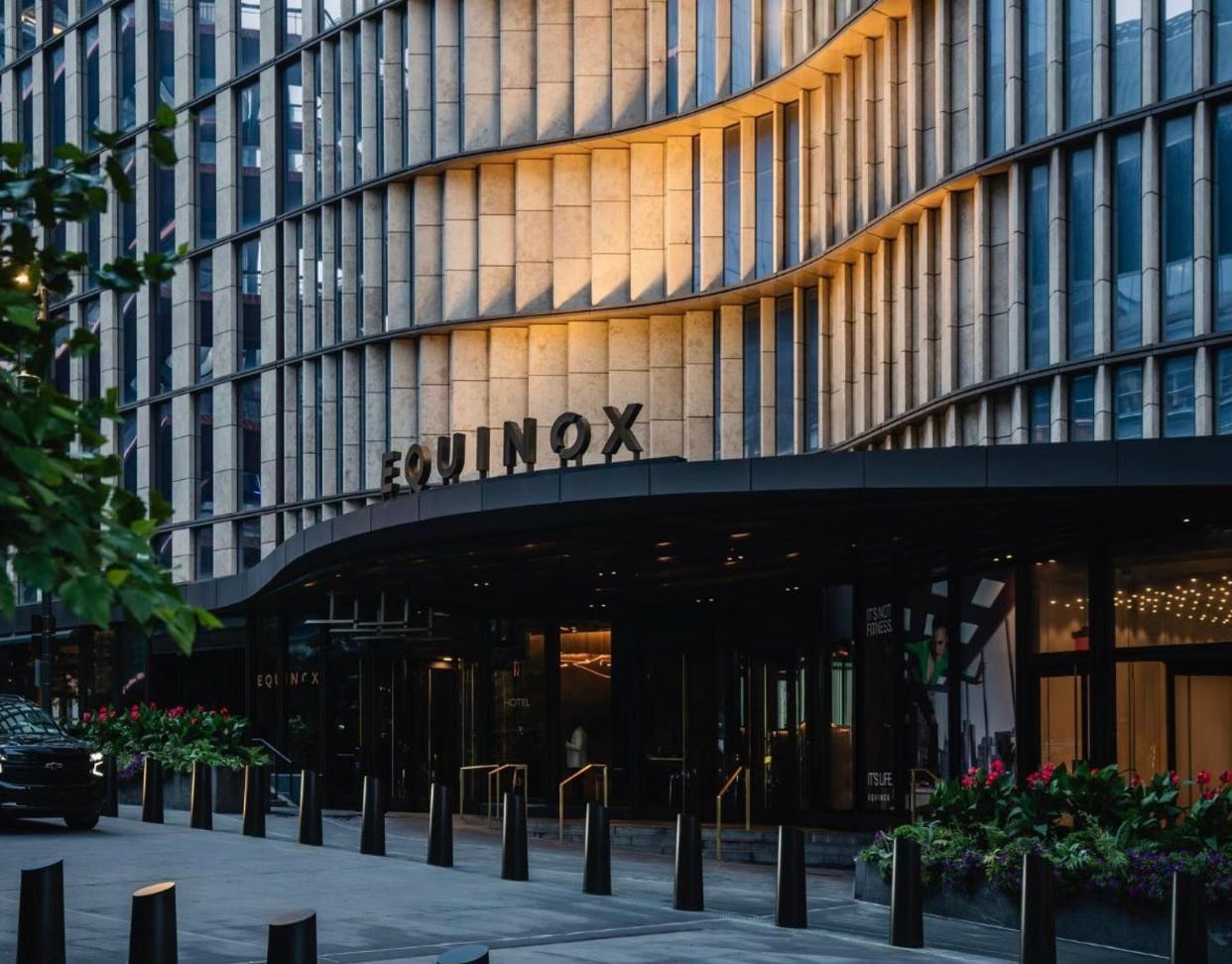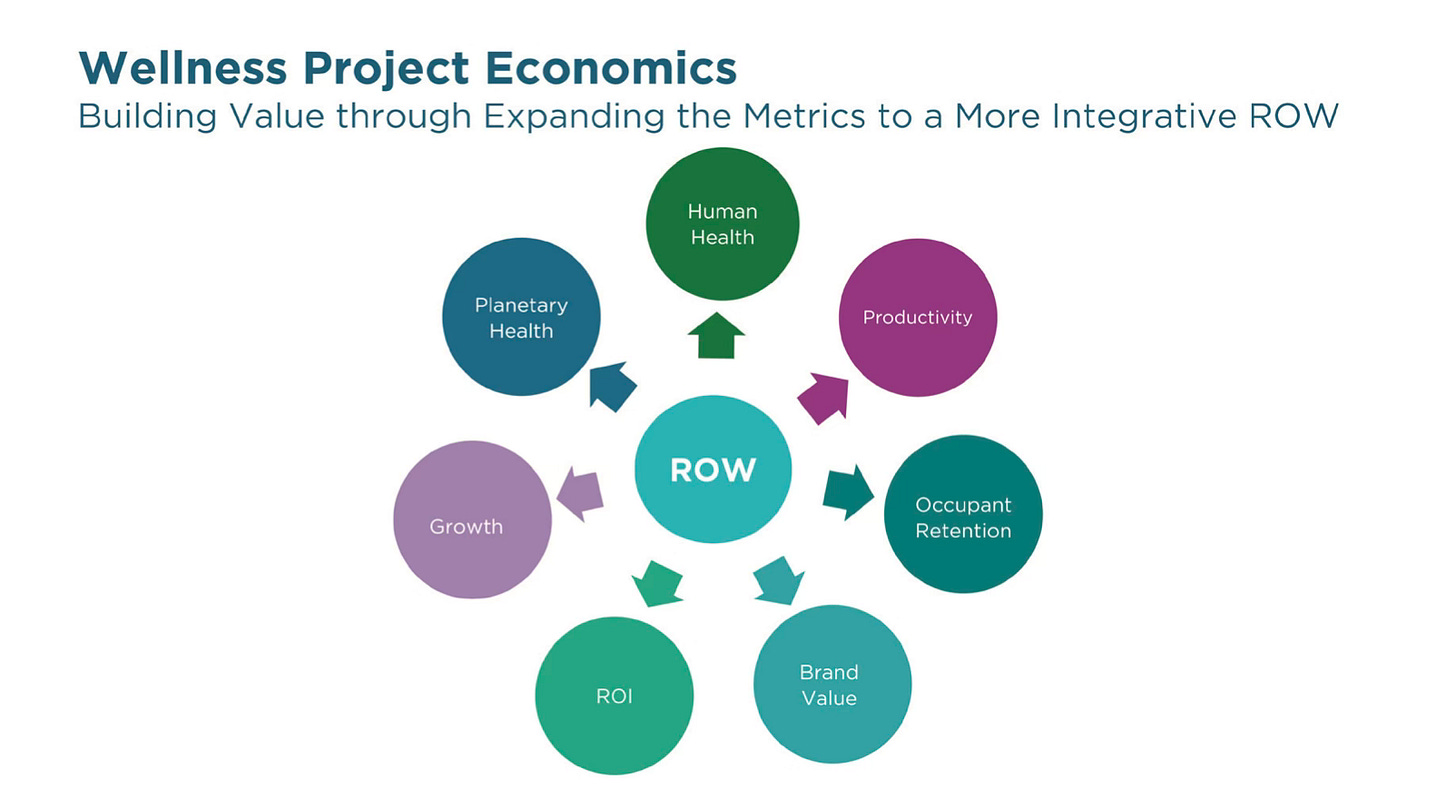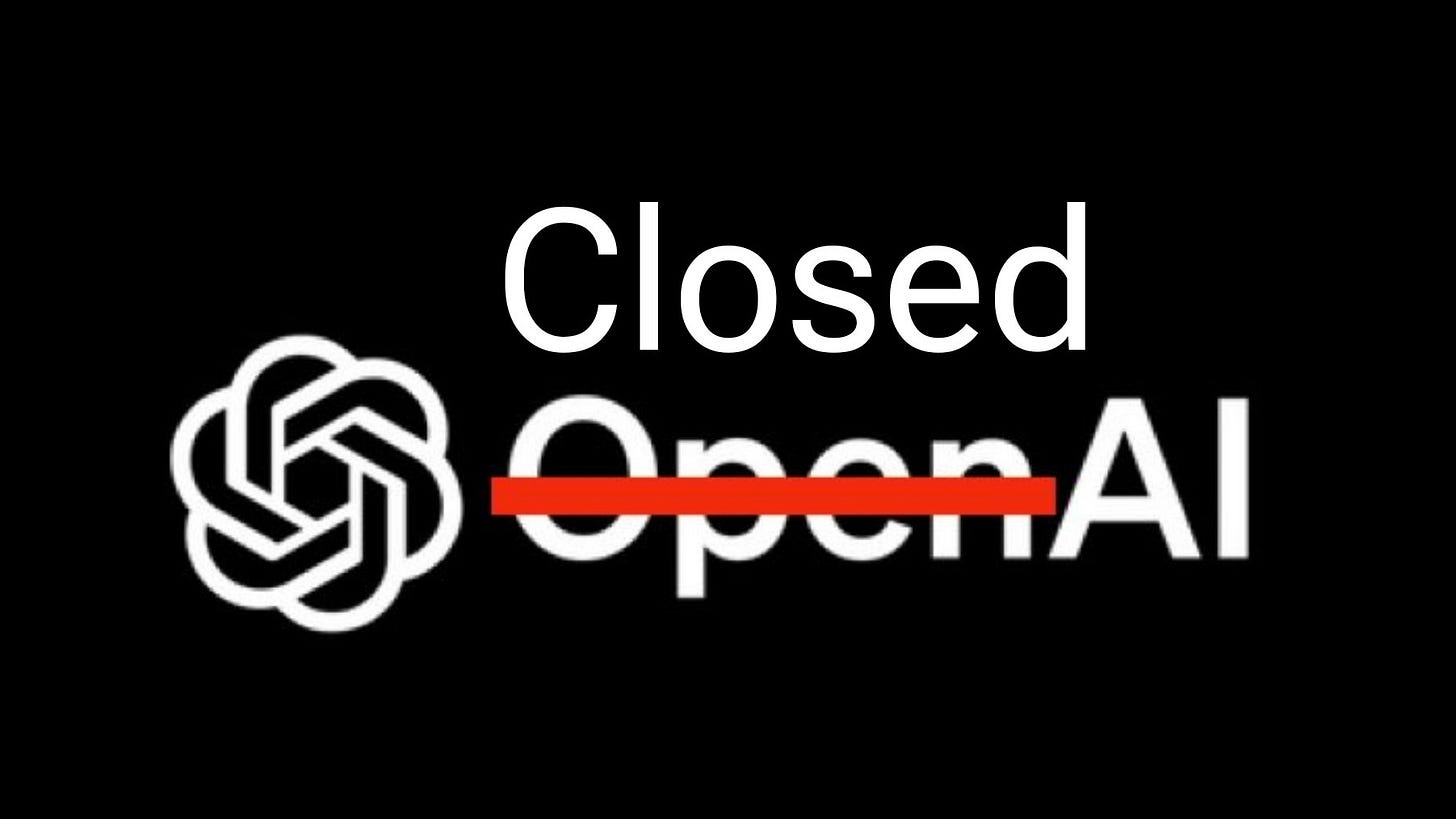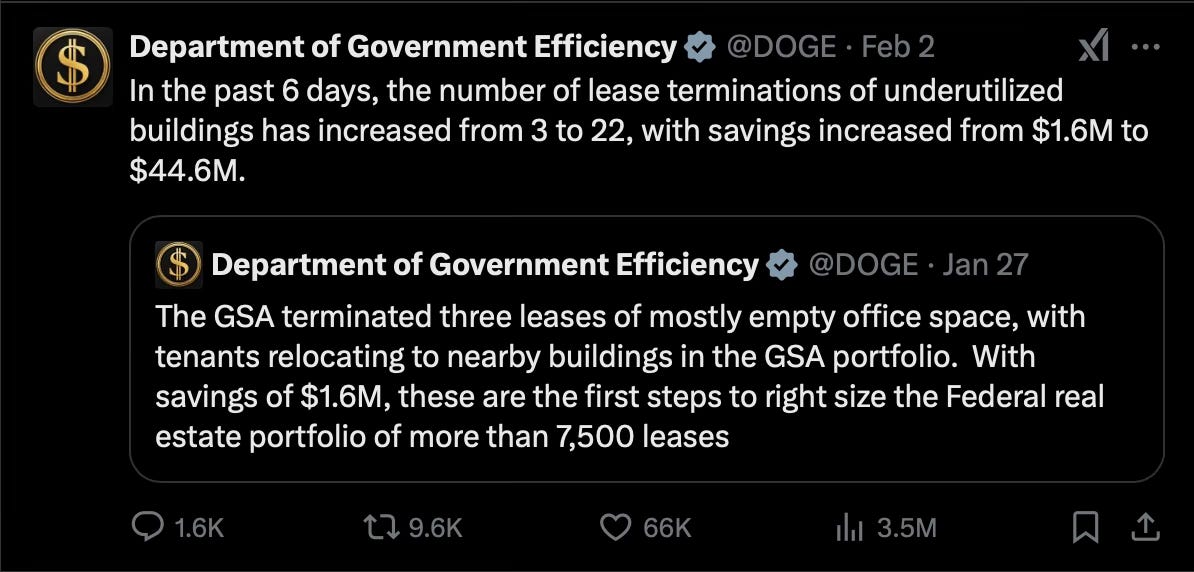DOGE, Design, & Disruption: The CRE Shake-Up, Equinox’s Real Estate Empire, and F1’s Game-Changing Louis Vuitton Deal
006: The Latest Headlines—And Who’s Losing Big in 2025

Happy (Belated) National Croissant Day!
Yes, I know—I’m late (don’t come for me). But I had to hold off on celebrating while wrapping up my final days of Whole30 because, well…croissants don’t exactly make the cut.
For the uninitiated, Whole30 is a strict elimination diet where you cut out grains, legumes, dairy, soy, sugar, and processed foods, leaving you with protein, fruits, veggies, and potatoes. After 30 days, you slowly reintroduce food groups to see how your body reacts. People swear by it for reduced brain fog, better sleep, more energy, and weight loss.
I already eat pretty clean, so I wasn’t expecting a life-changing transformation—but dropping nine pounds in January? I’ll take that as a win.
Now that Whole30 is officially behind me, here’s how I celebrated:
Yes, the croissant was worth the wait—and I might have overindulged a bit with the Super Bowl snacks this weekend. But as much as I love a good pastry moment, there’s something I think about way more often—the gym.
And not just any gym.
Equinox—the OG of high-end fitness in NYC.
Equinox is Officially Manhattan’s Biggest Retail Tenant
With 1.3 million square feet across 31 locations, the luxury fitness giant has surpassed Macy’s—and it’s showing no signs of slowing down.
How Equinox Built a Fitness Empire
Founded in 1991 on the Upper West Side, Equinox grew steadily before being acquired by private equity in 2000.
By 2006, Related Companies’ Stephen Ross took a controlling stake, shifting the company’s expansion strategy.
Initially, growth focused on high-profile flagship locations, but once brand recognition was established, the goal became filling in gaps between clubs to dominate key markets.
Aggressive Expansion, Fueled by $1.8 Billion
In March 2024, Equinox secured a $1.8 billion investment from Sixth Street and Silver Lake.
The company is now ramping up deals, looking at ground-up developments where they can custom-design space with developers.
Expansion isn’t limited to NYC, LA, and Miami. They’re now moving into Charlotte, Denver, Seattle, Atlanta, and just signed a 37,000-square-foot lease at the former Office Depot HQ in Boca Raton.
The Competition & Changing Fitness Landscape
Life Time Fitness has emerged as a key competitor, now operating seven locations in Manhattan, including an 80,000-square-foot flagship at One Wall Street.
The industry is shifting toward nostalgic, mid-century-inspired “sporting clubs,” moving away from Equinox’s signature sleek aesthetic.
What’s Next?
Equinox’s head of development, Jeff Weinhaus, believes they can double their footprint, stating:
“There’s no cap on how big we can grow in Manhattan…110 clubs can be 220 clubs-plus.”
With no cap on growth in Manhattan and the backing of major private equity, Equinox isn’t just a gym—it’s a real estate powerhouse. But that doesn’t mean they can take their foot off the gas.
Smaller wellness clubs like Chelsea Piers Fitness and Life Time are gaining market share. While they might not have Equinox’s scale, they’re carving out niches in a growing industry.
The Equinox Membership Debate: Is It Worth It?
Full disclosure: I’ve been a member at two Equinox locations for over four years. Do I think it’s overpriced? Maybe. But in NYC, there aren’t many alternatives that match its cleanliness and amenities —so maybe not.
Beyond the workouts, the people you meet in the gym (and in the sauna) are just as valuable. I love striking up conversations with other members and hearing about their experiences.
Lately, the topic of discussion? Equinox’s controversial New Year’s campaign—“Commit to Something.”

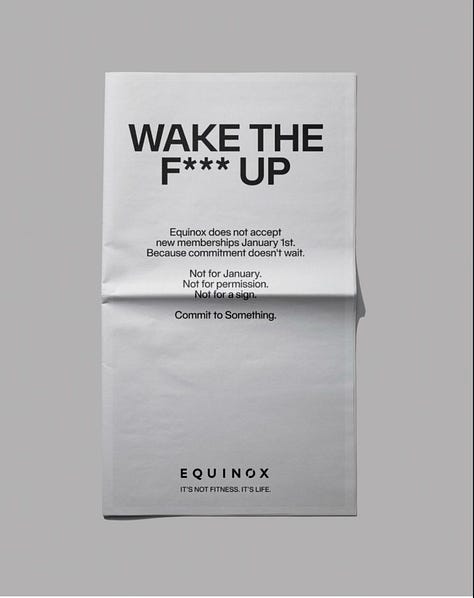

The Genius of Equinox’s “No New Members on Jan 1” Campaign
Here’s what I found:
The marketing did exactly what it was supposed to do—get people talking. In a world where attention is a commodity, brands need to go against the grain to stand out. Equinox knows this.
This isn’t their first time sparking controversy. They’ve received criticism for bold campaigns in previous years.
At first, I thought they missed the mark—but the more I sat with it, the more I saw the genius behind it.
It’s rage bait, and it works. Their campaign became a hot topic among health and wellness creators, brand strategists, and marketing experts. That’s free advertising, whether you liked the messaging or not.
At a time when boutique wellness clubs are popping up everywhere, Equinox has managed to cut through the noise.
What do you think—brilliant strategy or a miss? Leave a comment and let me know if you agree or disagree with Equinox’s marketing.
Fashion Meets Motorsport: A New Era for F1
Ferrari just dropped the first official images of Charles Leclerc and Lewis Hamilton in their 2025 race suits, teasing what’s to come ahead of the team’s official livery reveal on February 18. The social media rollout confirmed a few key details about their helmet designs:
Leclerc is repping Monaco pride with a red-and-white helmet design.
Hamilton is bringing back his old-school yellow helmet—an homage to his McLaren and early Mercedes days.
And in a bizarre twist of fate, Hamilton crashed his Ferrari during pre-season testing in Barcelona. No injuries, just déjà vu—because he did the exact same thing when he first joined McLaren and Mercedes.
A bad omen? Or a sign of things to come? You tell me—he did go on to win seven world titles after those stumbles.
Hamilton’s Dream Team Vision: More Than Racing
Hamilton’s move to Ferrari isn’t just about chasing his eighth championship—it’s a long-term power play. Journalist Connor McDonagh suggests Hamilton could be at Ferrari for as long as he wants, even beyond racing, with opportunities in fashion, branding, and ambassadorships.
And this is where things get really interesting.
Ferrari isn’t just a motorsport giant—it’s a luxury brand with a growing in-house fashion line that extends far beyond race merch and polo shirts. Their ambitions in high fashion have been clear, but they haven’t quite broken through on the global stage.
Could Hamilton be the missing piece?
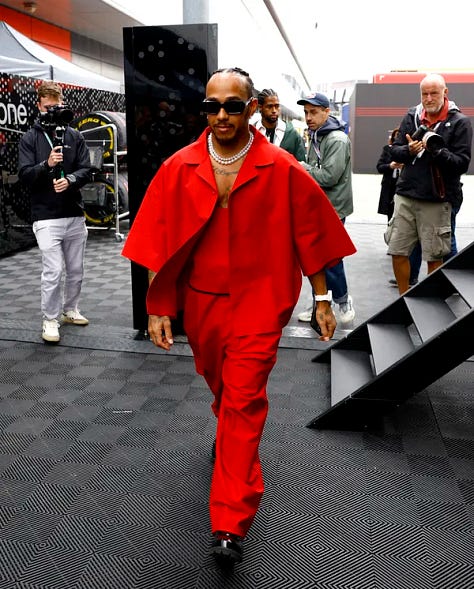
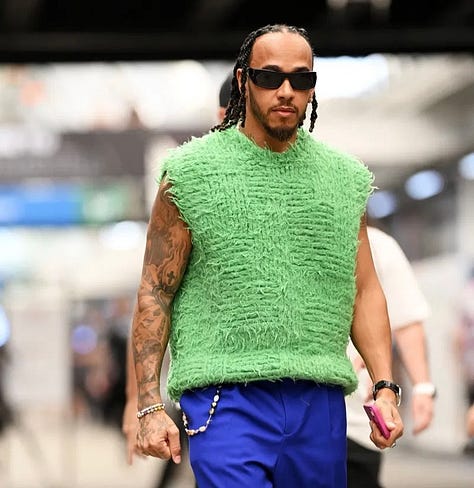

His cultural impact, combined with his bold fashion influence, could elevate Ferrari’s brand beyond motorsport and into the luxury fashion elite. If they play this right, Ferrari’s partnership with Hamilton could deliver not just a championship—but a brand renaissance.
His debut photoshoot for Ferrari kept things clean, classic, and intentional—a surprising restraint from F1’s biggest risk-taker in fashion. But make no mistake, this was calculated. The fit radiated pure Don energy, a nod to il Commendatore himself, Enzo Ferrari. He sought to capture Enzo’s timeless elegance—immortalized in countless photographs dressed in a coat, jacket, and tie—which became the blueprint. More than just a tribute, it was a statement—an assertion of presence, legacy, and intent. He’s not just here to race; he’s here to own the moment and reshape Ferrari’s legacy.
Even his former Mercedes boss, Toto Wolff, couldn’t help but acknowledge it—sending Hamilton one simple text after seeing the photos:
“Iconic.”
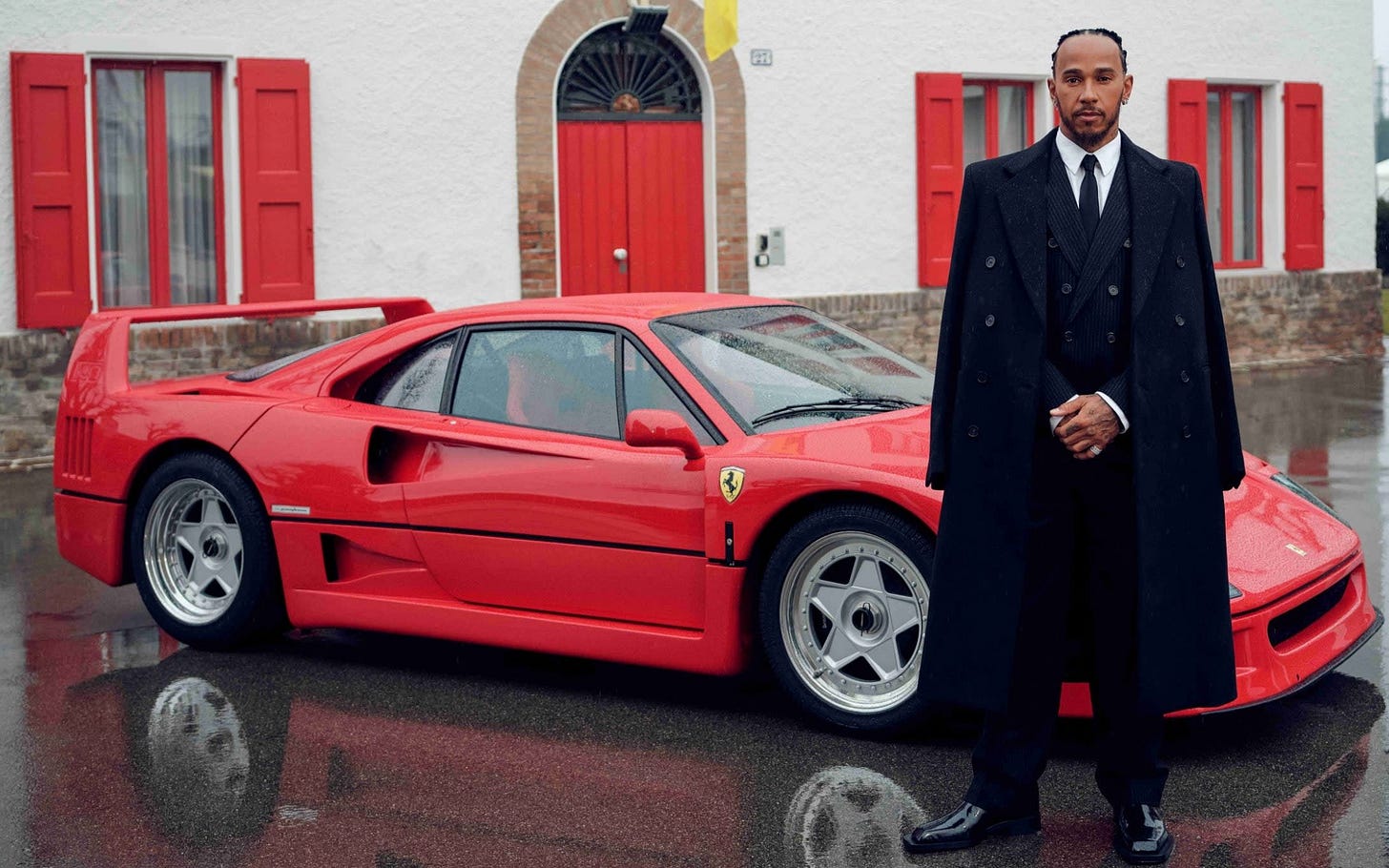
Louis Vuitton x Formula 1: A 10-Year Deal That Changes the Game
Speaking of fashion, Louis Vuitton just locked in a 10-year partnership with Formula 1, and will become the Title Partner of the season’s first race: the Formula 1 Louis Vuitton Australian Grand Prix 2025.
Pietro Beccari, Chairman and CEO of Louis Vuitton, hailed the partnership, stating:
“I am immensely proud of this partnership between Louis Vuitton and Formula 1, with our shared ambition to always strive for innovation, craft, and precision. The synergy of our two worlds is echoed in the savoir faire of our ateliers and garages, artisans, and engineers while celebrating the outstanding performance of champion drivers around the world who embark on a journey of excellence with every race.”
This is more than just another sponsorship—it’s a landmark crossover between luxury and motorsport. LV has been embedding itself deeper into the sports world, crafting trophy trunks for events like the World Cup, NBA Finals, and the Olympics. But its ties to F1 aren’t new—this partnership expands on an existing relationship.
Since 2021, Louis Vuitton has been designing the iconic Trophy Trunk for the Monaco Grand Prix. This new deal? It takes things to the next level.





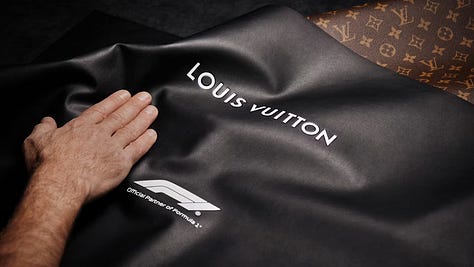
Formula 1 and LVMH called the deal an “unprecedented agreement between the world leader in luxury and the pinnacle of motorsport.”
Translation: We’re about to witness the most stylish era of F1 yet.
Final Thoughts
With Hamilton’s Ferrari era officially in motion and Louis Vuitton planting its flag in F1, 2025 is shaping up to be a cultural moment for the sport. The fusion of luxury, legacy, and competition has never been stronger.
So, do you think Ferrari is setting up Hamilton for title #8? Will F1’s luxury play take the sport to new heights?
The Future of Wellness Architecture and Design
The Global Wellness Institute (GWI) has unveiled a new white paper on Wellness Architecture & Design, redefining how we approach the spaces where we live, work, and play. This isn’t just about trendy amenities or sustainability buzzwords—it’s about centering health, happiness, and well-being in every aspect of design, from urban planning to interior design. Drawing insights from the $6.3 trillion wellness economy, the report lays out a roadmap for creating environments that allow people and the planet to thrive.
The paper challenges architects, developers, and policymakers to look beyond aesthetics and profits, focusing instead on how the built environment can actively enhance our well-being. By tracing the evolution of the wellness movement, the paper underscores that health is more than just the absence of disease—it’s about nurturing balance, fulfillment, and connection to the world around us. This holistic view feeds into the concept of the “wellness economy,”. The paper outlines seven key pillars of wellness from physical and mental health to financial and environmental stewardship and social inclusion. The report explores strategies at every scale: 15-minute neighborhoods, climate-responsive architecture, and calming interior spaces featuring natural light, mindful color palettes, and “thin places” for quiet reflection.
In tandem with biophilic design, local food production, and smart infrastructure, the document introduces the idea of “Return on Wellness” (ROW), expanding beyond traditional ROI to measure a project’s lasting impact on health, happiness, and the planet. It also highlights the role of governments in promoting accessible and affordable wellness-focused developments. Ultimately, the white paper envisions a future where spaces aren’t just places to live but catalysts for thriving communities, environmental resilience, and holistic well-being.
What’s your take—are we ready to prioritize wellness over convention in how we build our world? Read the report here.
As promised, let’s dive into this week’s rundown of the biggest losers for the year ahead.
The Biggest Losers of 2025:
The Fall of OpenAI
Surprise, surprise—just kidding. This one was obvious.
The recent explosion of DeepSeek’s R1 model has shifted the conversation. It’s no longer about who will dethrone OpenAI, but whether open-source AI is rewriting the rules of the game. If cutting-edge models can be trained with far fewer GPUs and AI chips than previously thought, does that mean chipmakers like NVIDIA are losing their grip?
The short answer is no, and here’s why:
The rise of open-source AI isn’t killing demand for chips—it’s supercharging it. More competition = more models = more need for computing power. The assumption that fewer GPUs are needed per model doesn’t account for the sheer number of models now being built. The barrier to entry is lower, but that just means more players entering the space, all hungry for processing power.
So why the bearish take on OpenAI?
For OpenAI, the threat isn’t the chip market—it’s the business model.
The emergence of powerful open-source AI models is challenging OpenAI’s closed-source approach. These alternatives deliver comparable performance at a fraction of the cost, making them highly attractive to developers who want control, flexibility, and scalability without vendor lock-in. The market’s shifting preferences could chip away at OpenAI’s dominance, forcing it to rethink its pricing and accessibility strategies.
Money Money Money Money, MONEY!
OpenAI’s operational costs are projected to hit $5 billion this year—with a staggering $4 billion going to Microsoft Azure servers alone.
Its token-based pricing model means costs scale with usage—GPT-4 runs $10 to $60 per million tokens, and high-definition images via DALL-E 3 cost $8 per 100 images. Even with projected 2024 revenue of $3.7 billion (including $2.7 billion from ChatGPT alone), OpenAI still isn’t profitable. Its $200/month ChatGPT Pro plan is a loss leader, and internal projections suggest it won’t break even until 2029, when it aims for $100 billion in annual sales.
How does this play out?
One thing is clear: OpenAI is running out of time to fix its business model.
With open-source competition rising and costs spiraling, the company has two options: slash expenses or secure massive investment rounds. So far, it’s chosen the latter, locking in funding through The Stargate Project and now reportedly in talks to raise $40 billion. Either OpenAI has next-level tech it hasn’t released to the public—or it’s pulling off one of the most ambitious sales jobs in Silicon Valley history.
Regardless, OpenAI has delivered unparalleled breakthroughs in AI—but the real test is whether it can turn those into sustainable dominance or if it will be the biggest loser of 2025.
The Office Purge: How DOGE is Reshaping CRE
The federal government is about to flood the market with vacant office space, and the financial impact could be massive. Let’s break it down:
Government-Owned Office Space: The Big Sell-Off
What’s Happening?
The federal government owns and leases ~ 370 million square feet of office space.
Selling two-thirds of it would mean divesting more than 200 million square feet.
Financial Impact:
The revenue generated from these sales will depend on market conditions but expect billions in transactions.
The real win for the government? Cutting maintenance costs, which are a perpetual drain on federal budgets.
Leased Office Space: The $4B Question
What’s Happening?
The GSA (General Services Administration) leases 149.5 million square feet of office space.
The plan? Terminate 75% of these leases, cutting 112 million square feet from government use.
Financial Impact:
The government spends $5.25 billion annually on rent for leased office space, an average office rental rate of $35.09 per square foot.
If three-quarters of these leases disappear, the government could save approximately $3.94 billion annually.
This could potentially save around $3.94 billion annually in lease payments. However, it’s important to note that not all leases can be canceled overnight due to contractual obligations. For instance, in 2025, the GSA has termination rights on 21.2 million square feet, which could save approximately $260 million in annual rent if terminated.
Too Much Supply, Not Enough Demand?
Dropping this much space onto the market will put downward pressure on office property values—bad news for landlords already struggling with high vacancies.
The government’s real estate purge is one of the biggest shake-ups CRE has seen in decades. Firms like Blackstone and Brookfield are watching closely as the sell-off will create distressed asset opportunities for well-capitalized buyers.
Already making moves, DOGE tweeted on Sunday, Feb 2, that it has saved $44.6 million by terminating 22 leases—and this is just the beginning.
The question now:
Is this a once-in-a-generation opportunity to buy or the biggest flop of 2025?
Either way, big players are circling, and the next moves could define the future of office real estate.
The Detox Era: Harmful Chemicals Are Out
2025 is shaping up to be the year of elimination, and the biggest loser? Harmful chemicals.
With Robert F. Kennedy Jr. tapped as HHS Secretary, public health policy could take a sharp turn. Known for his controversial views on vaccines and fluoridation, RFK Jr. has long criticized the FDA’s regulatory failures and emphasized the link between food quality and chronic disease. His appointment signals a potential shift away from traditional health policies and a stronger focus on eliminating toxins from our daily lives.
Meanwhile, the consumer awakening is well underway.
Seed oils are under fire.
Microplastics are contaminating our clothes, water, and bloodstream.
Toxic food dyes are finally getting banned (goodbye, Red Dye No. 3).
Pesticides, PFAS, and endocrine disruptors are lurking everywhere—from cookware and drinking water to fabrics and even smartwatches (yes, your fitness tracker might be leaching chemicals into your skin).
At this point, it feels like everything is out to kill us or give us cancer. But the best defense? Taking control.
The food we eat, the clothes we wear, the products we put on our skin—they either fuel our health or slowly poison us. The good news? Awareness is rising, regulations are tightening, and consumers are demanding better.
The Detox Era isn’t just about cutting toxins—it’s about redefining what “healthy” actually means in a world that’s been built on hidden chemicals.
How to Reduce Your Exposure
Want to cut harmful chemicals from your life? Start with these key areas:
Cookware – Avoid nonstick coatings (Teflon), black plastic, and flame-retardant materials. Instead, opt for stainless steel, cast iron, or ceramic. (CNN Report on toxic black plastic cookware)
Containers & Glassware – Ditch plastic and switch to glass or stainless steel for drinkware and food storage. Never microwave food in plastic containers. Heat can cause chemicals like BPA and phthalates to leach into your food, increasing the risk of hormone disruption and other health issues.
Water – Invest in a high-quality carbon water filter to reduce exposure to Chlorine, Pesticides, and heavy metals.
Clothing – Fast fashion is loaded with endocrine disruptors. Look for organic, untreated fabrics (think 100% cotton, hemp, or merino wool).
Beauty & Personal Care – Your skincare and makeup should be free from parabens, phthalates, and synthetic fragrances. If you wouldn’t eat it, why put it on your skin?
Smartwatches & Wearables – Many brands use PFAS (like PFHxA, a notorious “forever chemical”) in watch bands for their resistance to water, sweat, and oil—making them durable but potentially dangerous. The problem? These chemicals don’t just stay on the band—they transfer to your skin and can be absorbed into your body.
PFHxA has been linked to liver cancer and other health risks, making it a hidden hazard in everyday wear.
Better Alternatives? Ditch the rubber band and opt for safer materials like silicone, canvas, metal, or leather.
You don’t have to toss everything overnight. Small changes add up over time. Start swapping out the worst offenders, and before you know it, you’ll have built a healthier, toxin-free lifestyle.
The Dead Internet Theory
Are We Already Living in an AI-Generated World?
The internet as we know it is changing, and if you’ve heard of the Dead Internet Theory, you know exactly what I mean. If not, let me enlighten you.
AI Is Becoming Indistinguishable from Reality
Fake social media profiles, AI-generated influencers, and algorithmically driven content—we’re already engaging with AI without realizing it.
Gary Vee predicts that future generations will have relationships with AI.
Meta is rolling out AI-generated social media users on Instagram and Facebook.
Google’s VEO2 is taking AI video generation to new heights, making it harder to tell what’s real and what’s not.
At this point, we have to question everything we see online. Is that article, comment, or social media post human-generated—or is it just another AI model running in the background?
AI Is Disrupting Jobs & Income—Fast
While companies rush to implement generative AI at scale, regulatory and compliance concerns are making it challenging. But for those who can execute, AI has already proven to be a massive efficiency booster.
Mark Zuckerberg stated that AI will soon replace mid-level engineers.
“Probably in 2025, we at Meta, as well as other companies working on this, are going to have an AI that can effectively be a sort of mid-level engineer at your company that can write code.”
He made this bold claim during his interview on The Joe Rogan Experience, suggesting that AI code generation is nearing a level where it can replicate human engineers.
And it’s not just engineering…
With AI tools, anyone can start a business, build a website, design a logo, and automate operations—what used to require specialized skills and a team can now be done with a few clicks.
That means entire industries are on the verge of being commoditized.
If You Sell Software, You’re in the Crosshairs…
What was once difficult and expensive to build is now accessible and cheap. Software businesses that thrived on complexity and exclusivity are about to face serious pressure.
Survival now depends on two things: distribution and, if possible, a regulatory moat.
Distribution: If your product can be easily replicated, your edge lies in how well you can reach and retain customers.
Regulatory Moat: If AI can build it, you need barriers that prevent just anyone from competing.
Take FDA approval, for example. It’s a lengthy, expensive process, but for AI-driven health tech companies, it’s one of the few ways to create a strong competitive advantage—not because of the technology, but because of the red tape.
This is the new reality: AI isn’t just leveling the playing field—it’s erasing it.
How Will We Spend Our Time?
Instead of asking “What happens when we lose our jobs?”, maybe the real question is:
What will we do with more time and money?
As AI drives massive deflationary shifts, costs will drop, efficiency will soar, and time will become our most abundant resource.
So ask yourself: If work was no longer a necessity, how would you choose to spend your time?
Quick Hits: Top Headlines You Need to Know:
Satisfy secures €11M in Series B funding to target €100M revenue
Monograph Raised $20M to Transform Architecture and Engineering Firms
Dior is Set to Debute First Wellness Retreat at the Hôtel du Cap-Eden-Roc
“To give anything less than your best is to sacrifice the gift”.
- Steve Prefontaine


